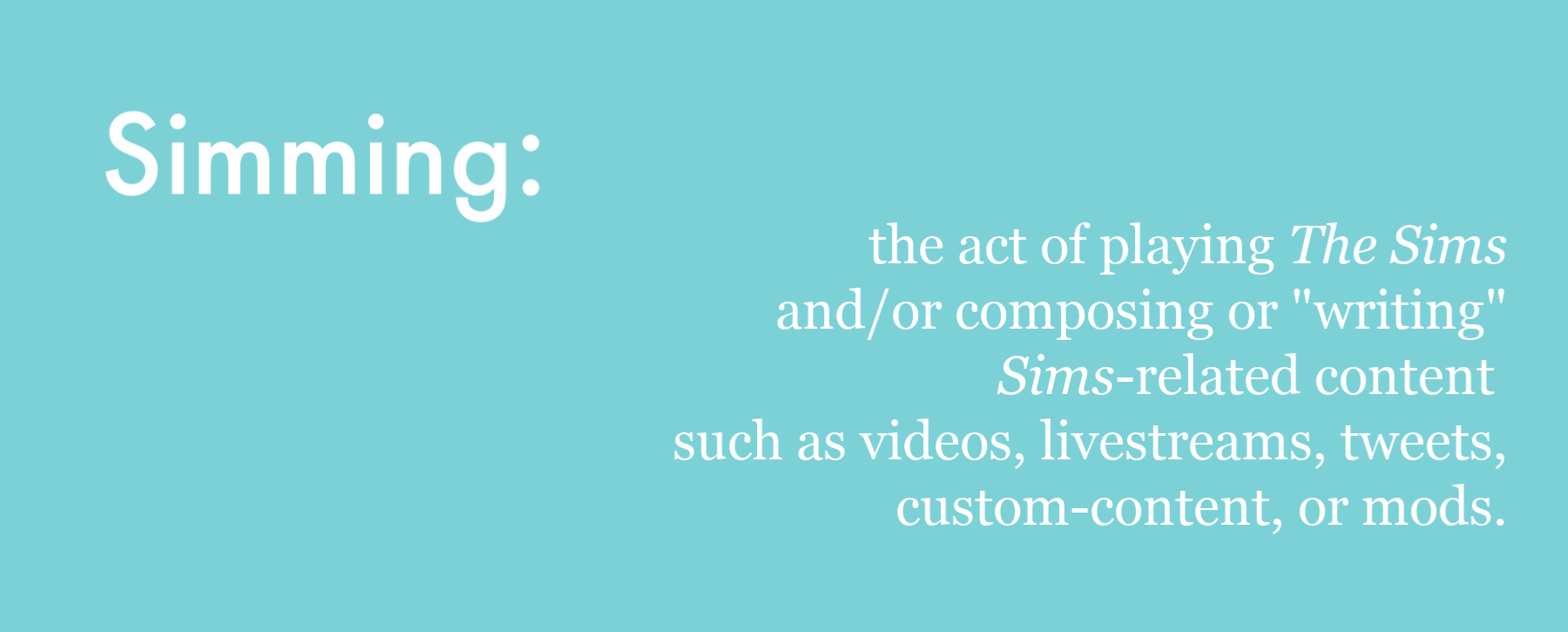Defining Content Creation:
Simming content takes many forms and falls under the purview of Writing Studies
Simming content creators act as a kind of writer, inhabiting an ecology that influences the production of their Simming content. The forms of content composed in this ecology vary widely, but some of the more popular compositions are videos, livestreams, tweets, and content that directly interjects into the game engine's code, like custom-content (CC) and modifications (mods). Examples illustrating the range of Simming content can be found on the left.
While "Simming" and the processes that constitute it may not initially appear to be a form of writing, its interconnected content creation falls under the purview of Writing Studies scholars. An older Pew Research report positions online content as "the material people contribute to the online world" (Lenhart et al.). Therefore, it logically follows that content creation is the making of this material. In her 2015 article "When Writing Becomes Content" Lisa Dush argues that content is a site ripe with possibility for Writing Studies scholars: "if our field takes seriously the claim...that writing has become content...we can open up propositions about digital-age writing for deeper inquiry, usher...content practices and professions into our sphere of concern, and confront a fast-moving phenomenon ripe for the sort of critical perspective that our field can provide" (174). In this article, Dush touches on the two ways of seeing how writing is becoming content--one view posits that content is "also" one of many forms of writing, and the other posits that writing has "become" content (175) due to the digital era's epistemological shifts.
Ultimately, "content" and "writing" can be thought of as overlapping synonyms with distinct, culturally tied burdens of connotation. Dush defines content "as writing" (178) but also "as digital assets, conditional in their shape and value, that are assembled within and pushed out to networks, where human and machine audiences will assess them, assign value to them, consume them, appropriate and repurpose thme, extract from them, and push them into other networks[emphasis not mine]"(178). While acknowledging that writing is a kind of content (or that content is a kind of writing), Dush argues that the words operate as metaphors. She writes, "Content...is a simple word with rich metaphoric connotations that can help us more fully see what it means to write in the digital age [emphasis not mine]" (Dush 190-191). Each word's connotations call forth distinct associations of materials and collaborators that shape the practice of research: "the writing metaphor does not particularly encourage us to envision alternative models of rhetorical space more germane to distributed networks" (Dush 181). Therefore, content may summon or encourage important considerations like the kinds of influences that interfaces and software can have on its creation, allowing for digital media's more distinct ecological components. However, rather than putting a stop to the use of the "writing" metaphor, Dush suggests that Writing Studies scholars "acknowledge writing's unavoidable status as content, keeping the two metaphors simultaneously in mind" (183). In following this advice, this project uses both "writing" and "content" to describe the compositions discussed while retaining a simultaneous acknowledgement of the loaded meanings that accompany both words.
The Simming ecology is an ideal site to begin investigating content creation through a Writing Studies framework. As we will see, Simming content creators frequently post about influences on their content creation process, and they acknowledge both human and non-human collaborators. Their public dialogue about their own communal productivity makes visible the exchange and interaction between content, writers, and other ecological elements. Furthermore, the nature of their content permits the wider public access to witnessing the ecological environment at play, during the composing process. Platforms like YouTube and Twitch permit rapid-fire exchange and interaction, with writers speaking about their composing decisions as they happen in real time. In these live streams and videos, viewers can often see the influences of other Simmers, materials, or ecological systems. Therefore, the interconnected nature of content creation is uniquely visible in this site.

